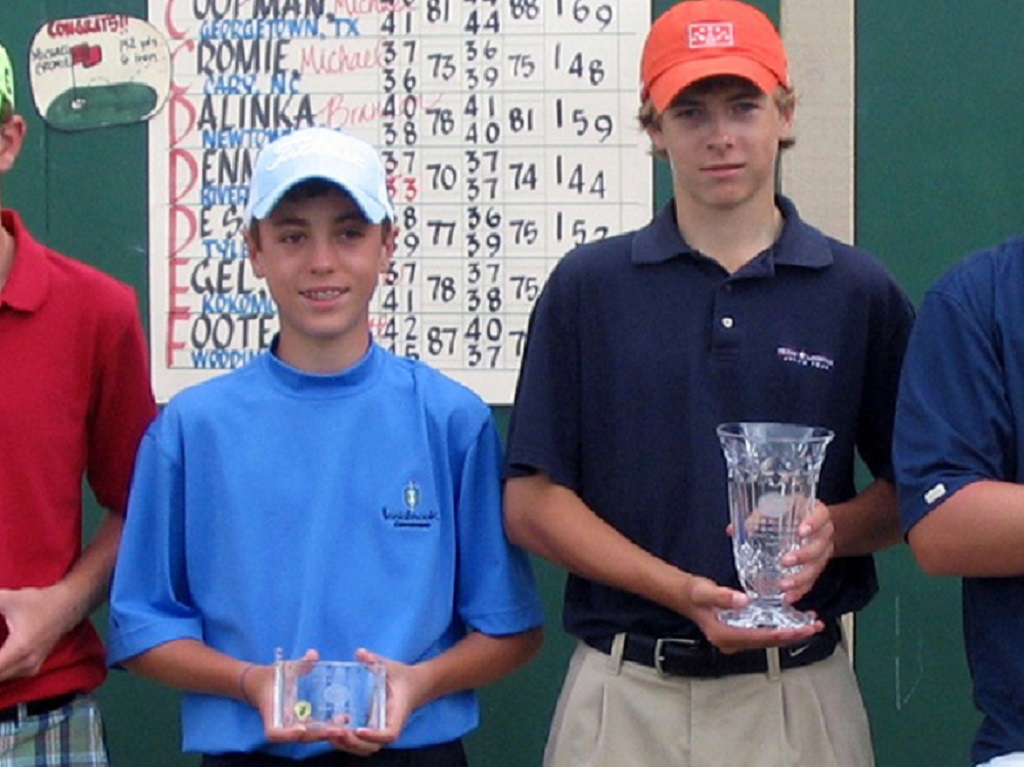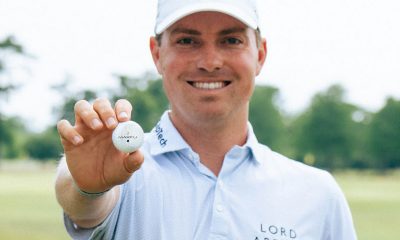Opinion & Analysis
Want to be an elite junior golfer? Play a shorter and easier home course

Let’s start with a thought experiment: You’re building a long-term plan with your parents to become a world-class golfer. You create a list. How important is being a member of a nice golf course? Is it worth the money to join somewhere swanky, or will the local muni do?
If you are like most junior golfers I have spoken to, facilities matter, and you want to be a member of that 7400-yard course with perfect greens. Based on this preference, I wanted to look at the data; what type of courses produce PGA Tour players? What can we learn from them? With the help of many of my friends in golf, I started to compile a list of PGA Tour players and their home golf courses when they were between 12-16 years old.
Here is what I came up with
- Justin Thomas – Harmony Landing: 6,645 (130 course rating)
- Justin Rose – North Hants: 6,250
- Brooks Koepka – Bear Lakes: 7,439 (141)
- Jordan Spieth – Brookhaven: 6,820 (133)
- Rory McIlroy – Hollywood Golf Club: 6,056
- Bubba Watson – Tanglewood Golf Club: 6,302 (124)
- Phil Mickelson – Stardust: 6,550 (126)
- Zach Johnson – Elmhurst: 6,500 (128)
- Webb Simpson – Raleigh Golf: 6,869 (135)
- Bryson DeChambeau – Dragon Fly: 7,273 (135)
- Ryan Moore – The Classic: 6,903 (134)
- Tiger Woods – Navy Golf Course: 6,780 (129)
- Ollie Sciednerjans – Bentwater: 6,741 (142)
- Xander Schauffele – Bernardo Heights: 6,679 (131)
- Chez Reavie – Dobson Ranch: 6,630 (121)
- Patrick Cantlay – Virginia Country Club: 6,633 (130)
- Jason Dufner – Weston Hills: 7,060 (129)
- Adam Hadwin – Morgan Creek: 6,948 (136)
- Emiliano Grillio -Chaco Golf Club: 6,749 (130)
- Charles Howell III – Augusta Country Club: 7,125 (136)
- Julian Suri – South Hampton: 7,028 (138)
- Aaron Wise – Eagle Glen: 6,869 (139)
- Peter Uihlein – IMG Academy: 6,842 (136)
- Brandon Stone – Centurion: 6,830 (131)
Starting to notice something? Based on the data of these 24 PGA Tour players, their average home course has a yardage of 6,772 and slope of 132. Wowzers! Can’t believe it? It makes perfect sense: To be competitive in golf, you must shoot under par. Shooting under par, like riding a bike, or walking, or writing, is a skill. It is developed through a combination of repetition and feedback.
Easier golf courses allow players the opportunity to shoot lower scores and build confidence. Over time, these skills become habit. When players enter tournaments, it is more likely they shoot under par. Breaking par at your home golf course is only the first step towards becoming an elite junior golfer. The data suggests that players (both boys and girls) need to average approximately 69 per round to win on the AJGA — on 6,800-yard courses for boys and just under 6,000 yards for girls.
No major championship venue has ever had a junior member go on to win, or even play, the PGA Tour. That’s right: the PGA Tour is not filled with junior members from Augusta National. Why? Because while playing Shinnecock Hills is an absolute treat, the course is extremely difficult, and 74 is a great score. Junior members at such courses create habits of shooting 74, and when they enter tournaments, like the AJGA, in general, they get beat.
So where should you be a member if you are a junior golfer with aspirations of college golf or beyond? Great question. In an ideal world the course would have the following:
- Unlimited access to a facility that is approximately 6,700 yards long with a slope of about 130. The goal on this golf course is to break par often and work towards a handicap of +3 by your 18th birthday.
- Somewhere with other talented players. Although, it would be great if they are other juniors, more importantly you want players of about the same skill who will offer you a competitive match a couple times a week.
As always, if you have any feedback on this article or a story idea, please feel free to reach out to me! Always love hearing from people and helping them connect with schools that meet their academic, athletic, social and financial needs!
- LIKE132
- LEGIT43
- WOW13
- LOL7
- IDHT1
- FLOP7
- OB2
- SHANK25
19th Hole
Vincenzi’s LIV Golf Singapore betting preview: Course specialist ready to thrive once again

After another strong showing in Australia, LIV Golf will head to Sentosa Golf Club in Singapore looking to build off of what was undoubtedly their best event to date.
Sentosa Golf Club sits on the southern tip of Singapore and is one of the most beautiful courses in the world. The course is more than just incredible scenically; it was also rated 55th in Golf Digest’s top-100 courses in 2022-2023 and has been consistently regarded as one of the best courses in Asia. Prior to being part of the LIV rotation, the course hosted the Singapore Open every year since 2005.
Sentosa Golf Club is a par 71 measuring 7,406 yards. The course will require precise ball striking and some length off the tee. It’s possible to go low due to the pristine conditions, but there are also plenty of hazards and difficult spots on the course that can bring double bogey into play in a hurry. The Bermudagrass greens are perfectly manicured, and the course has spent millions on the sub-air system to keep the greens rolling fast. I spoke to Asian Tour player, Travis Smyth, who described the greens as “the best [he’s] ever played.”
Davis Love III, who competed in a Singapore Open in 2019, also gushed over the condition of the golf course.
“I love the greens. They are fabulous,” the 21-time PGA Tour winner said.
Love III also spoke about other aspects of the golf course.
“The greens are great; the fairways are perfect. It is a wonderful course, and it’s tricky off the tee.”
“It’s a long golf course, and you get some long iron shots. It takes somebody hitting it great to hit every green even though they are big.”
As Love III said, the course can be difficult off the tee due to the length of the course and the trouble looming around every corner. It will take a terrific ball striking week to win at Sentosa Golf Club.
In his pre-tournament press conference last season, Phil Mickelson echoed many of the same sentiments.
“To play Sentosa effectively, you’re going to have a lot of shots from 160 to 210, a lot of full 6-, 7-, 8-iron shots, and you need to hit those really well and you need to drive the ball well.”
Golfers who excel from tee to green and can dial in their longer irons will have a massive advantage this week.
Stat Leaders at LIV Golf Adelaide:
Fairways Hit
1.) Louis Oosthuizen
2.) Anirban Lahiri
3.) Jon Rahm
4.) Brendan Steele
5.) Cameron Tringale
Greens in Regulation
1.) Brooks Koepka
2.) Brendan Steele
3.) Dean Burmester
4.) Cameron Tringale
5.) Anirban Lahiri
Birdies Made
1.) Brendan Steele
2.) Dean Burmester
3.) Thomas Pieters
4.) Patrick Reed
5.) Carlos Ortiz
LIV Golf Individual Standings:
1.) Joaquin Niemann
2.) Jon Rahm
3.) Dean Burmester
4.) Louis Oosthuizen
5.) Abraham Ancer
LIV Golf Team Standings:
1.) Crushers
2.) Legion XIII
3.) Torque
4.) Stinger GC
5.) Ripper GC
LIV Golf Singapore Picks
Sergio Garcia +3000 (DraftKings)
Sergio Garcia is no stranger to Sentosa Golf Club. The Spaniard won the Singapore Open in 2018 by five strokes and lost in a playoff at LIV Singapore last year to scorching hot Talor Gooch. Looking at the course setup, it’s no surprise that a player like Sergio has played incredible golf here. He’s long off the tee and is one of the better long iron players in the world when he’s in form. Garcia is also statistically a much better putter on Bermudagrass than he is on other putting surfaces. He’s putt extremely well on Sentosa’s incredibly pure green complexes.
This season, Garcia has two runner-up finishes, both of them being playoff losses. Both El Camaleon and Doral are courses he’s had success at in his career. The Spaniard is a player who plays well at his tracks, and Sentosa is one of them. I believe Sergio will get himself in the mix this week. Hopefully the third time is a charm in Singapore.
Paul Casey +3300 (FanDuel)
Paul Casey is in the midst of one of his best seasons in the five years or so. The results recently have been up and down, but he’s shown that when he’s on a golf course that suits his game, he’s amongst the contenders.
This season, Casey has finishes of T5 (LIV Las Vegas), T2 (LIV Hong Kong), and a 6th at the Singapore Classic on the DP World Tour. At his best, the Englishman is one of the best long iron players in the world, which makes him a strong fit for Sentosa. Despite being in poor form last season, he was able to fire a Sunday 63, which shows he can low here at the course.
It’s been three years since Casey has won a tournament (Omega Dubai Desert Classic in 2021), but he’s been one of the top players on LIV this season and I think he can get it done at some point this season.
Mito Pereira +5000 (Bet365)
Since Mito Pereira’s unfortunate demise at the 2022 PGA Championship, he’s been extremely inconsistent. However, over the past few months, the Chilean has played well on the International Series as well as his most recent LIV start. Mito finished 8th at LIV Adelaide, which was his best LIV finish this season.
Last year, Pereira finished 5th at LIV Singapore, shooting fantastic rounds of 67-66-66. It makes sense why Mito would like Sentosa, as preeminent ball strikers tend to rise to the challenge of the golf course. He’s a great long iron player who is long and straight off the tee.
Mito has some experience playing in Asia and is one of the most talented players on LIV who’s yet to get in the winner’s circle. I have questions about whether or not he can come through once in contention, but if he gets there, I’m happy to roll the dice.
Andy Ogletree +15000 (DraftKings)
Andy Ogletree is a player I expected to have a strong 2024 but struggled early in his first full season on LIV. After failing to crack the top-25 in any LIV event this year, the former U.S. Amateur champion finally figured things out, finished in a tie for 3rd at LIV Adelaide.
Ogletree should be incredible comfortable playing in Singapore. He won the International Series Qatar last year and finished T3 at the International Series Singapore. The 26-year-old was arguably the best player on the Asian Tour in 2023 and has been fantastic in the continent over the past 18 months.
If Ogletree has indeed found form, he looks to be an amazing value at triple-digit odds.
- LIKE3
- LEGIT3
- WOW1
- LOL1
- IDHT0
- FLOP2
- OB0
- SHANK0
Opinion & Analysis
Ryan: Lessons from the worst golf instructor in America

In Tampa, there is a golf course that boasts carts that do not work, a water range, and a group of players none of which have any chance to break 80. The course is overseen by a staff of crusty men who have succeeded at nothing in life but ending up at the worst-run course in America. However, this place is no failure. With several other local courses going out of business — and boasting outstanding greens — the place is booked full.
While I came for the great greens, I stayed to watch our resident instructor; a poor-tempered, method teacher who caters to the hopeless. At first, it was simply hilarious. However, after months of listening and watching, something clicked. I realized I had a front-row seat to the worst golf instructor in America.
Here are some of my key takeaways.
Method Teacher
It is widely accepted that there are three types of golf instructors: system teachers, non-system teachers, and method teachers. Method teachers prescribe the same antidote for each student based on a preamble which teachers can learn in a couple day certification.
Method teaching allows anyone to be certified. This process caters to the lowest caliber instructor, creating the illusion of competency. This empowers these underqualified instructors with the moniker of “certified” to prey on the innocent and uninformed.
The Cult of Stack and Jilt
The Stack and Tilt website proudly boasts, “A golfer swings his hands inward in the backswing as opposed to straight back to 1) create power, similar to a field goal kicker moving his leg in an arc and 2) to promote a swing that is in-to-out, which produces a draw (and eliminates a slice).”
Now, let me tell you something, there is this law of the universe which says “energy can either be created or destroyed,” so either these guys are defying physics or they have no idea what they are taking about. Further, the idea that the first move of the backswing determines impact is conjecture with a splash of utter fantasy.
These are the pontifications of a method — a set of prescriptions applied to everyone with the hope of some success through the placebo effect. It is one thing for a naive student to believe, for a golf instructor to drink and then dispel this Kool-Aid is malpractice.
Fooled by Randomness
In flipping a coin, or even a March Madness bet, there is a 50-50 chance of success. In golf, especially for new players, results are asymmetric. Simply put: Anything can happen. The problem is that when bad instructors work with high handicappers, each and every shot gets its own diagnosis and prescription. Soon the student is overwhelmed.
Now here’s the sinister thing: The overwhelming information is by design. In this case, the coach is not trying to make you better, they are trying to make you reliant on them for information. A quasi Stockholm syndrome of codependency.
Practice
One of the most important scientists of the 20th century was Ivan Pavlov. As you might recall, he found that animals, including humans, could be conditioned into biological responses. In golf, the idea of practice has made millions of hackers salivate that they are one lesson or practice session from “the secret.”
Sunk Cost
The idea for the worst golf instructor is to create control and dependency so that clients ignore the sunk cost of not getting better. Instead, they are held hostage by the idea that they are one lesson or tip away from unlocking their potential.
Cliches
Cliches have the effect of terminating thoughts. However, they are the weapon of choice for this instructor. Add some hyperbole and students actually get no information. As a result, these players couldn’t play golf. When they did, they had no real scheme. With no idea what they are doing, they would descend into a spiral of no idea what to do, bad results, lower confidence, and running back to the lesson tee from more cliches.
The fact is that poor instruction is about conditioning players to become reliant members of your cult. To take away autonomy. To use practice as a form of control. To sell more golf lessons not by making people better but through the guise that without the teacher, the student can never reach their full potential. All under the umbrella of being “certified” (in a 2-day course!) and a melee of cliches.
This of course is not just happening at my muni but is a systemic problem around the country and around the world, the consequences of which are giving people a great reason to stop playing golf. But hey, at least it’s selling a lot of golf balls…
- LIKE15
- LEGIT1
- WOW0
- LOL3
- IDHT1
- FLOP0
- OB0
- SHANK12
19th Hole
Vincenzi’s 2024 Zurich Classic of New Orleans betting preview

The PGA TOUR heads to New Orleans to play the 2023 Zurich Classic of New Orleans. In a welcome change from the usual stroke play, the Zurich Classic is a team event. On Thursday and Saturday, the teams play best ball, and on Friday and Sunday the teams play alternate shot.
TPC Louisiana is a par 72 that measures 7,425 yards. The course features some short par 4s and plenty of water and bunkers, which makes for a lot of exciting risk/reward scenarios for competitors. Pete Dye designed the course in 2004 specifically for the Zurich Classic, although the event didn’t make its debut until 2007 because of Hurricane Katrina.
Coming off of the Masters and a signature event in consecutive weeks, the field this week is a step down, and understandably so. Many of the world’s top players will be using this time to rest after a busy stretch.
However, there are some interesting teams this season with some stars making surprise appearances in the team event. Some notable teams include Patrick Cantlay and Xander Schauffele, Rory McIlroy and Shane Lowry, Collin Morikawa and Kurt Kitayama, Will Zalatoris and Sahith Theegala as well as a few Canadian teams, Nick Taylor and Adam Hadwin and Taylor Pendrith and Corey Conners.
Past Winners at TPC Louisiana
- 2023: Riley/Hardy (-30)
- 2022: Cantlay/Schauffele (-29)
- 2021: Leishman/Smith (-20)
- 2019: Palmer/Rahm (-26)
- 2018: Horschel/Piercy (-22)
- 2017: Blixt/Smith (-27)
2024 Zurich Classic of New Orleans Picks
Tom Hoge/Maverick McNealy +2500 (DraftKings)
Tom Hoge is coming off of a solid T18 finish at the RBC Heritage and finished T13 at last year’s Zurich Classic alongside Harris English.
This season, Hoge is having one of his best years on Tour in terms of Strokes Gained: Approach. In his last 24 rounds, the only player to top him on the category is Scottie Scheffler. Hoge has been solid on Pete Dye designs, ranking 28th in the field over his past 36 rounds.
McNealy is also having a solid season. He’s finished T6 at the Waste Management Phoenix Open and T9 at the PLAYERS Championship. He recently started working with world renowned swing coach, Butch Harmon, and its seemingly paid dividends in 2024.
Keith Mitchell/Joel Dahmen +4000 (DraftKings)
Keith Mitchell is having a fantastic season, finishing in the top-20 of five of his past seven starts on Tour. Most recently, Mitchell finished T14 at the Valero Texas Open and gained a whopping 6.0 strokes off the tee. He finished 6th at last year’s Zurich Classic.
Joel Dahmen is having a resurgent year and has been dialed in with his irons. He also has a T11 finish at the PLAYERS Championship at TPC Sawgrass which is another Pete Dye track. With Mitchell’s length and Dahmen’s ability to put it close with his short irons, the Mitchell/Dahmen combination will be dangerous this week.
Taylor Moore/Matt NeSmith +6500 (DraftKings)
Taylor Moore has quickly developed into one of the more consistent players on Tour. He’s finished in the top-20 in three of his past four starts, including a very impressive showing at The Masters, finishing T20. He’s also finished T4 at this event in consecutive seasons alongside Matt NeSmith.
NeSmith isn’t having a great 2024, but has seemed to elevate his game in this format. He finished T26 at Pete Dye’s TPC Sawgrass, which gives the 30-year-old something to build off of. NeSmith is also a great putter on Bermudagrass, which could help elevate Moore’s ball striking prowess.
- LIKE8
- LEGIT3
- WOW1
- LOL1
- IDHT0
- FLOP3
- OB1
- SHANK2
-

 19th Hole1 week ago
19th Hole1 week agoJustin Thomas on the equipment choice of Scottie Scheffler that he thinks is ‘weird’
-

 19th Hole1 week ago
19th Hole1 week ago‘Absolutely crazy’ – Major champ lays into Patrick Cantlay over his decision on final hole of RBC Heritage
-

 19th Hole2 weeks ago
19th Hole2 weeks agoTwo star names reportedly blanked Jon Rahm all week at the Masters
-

 19th Hole2 weeks ago
19th Hole2 weeks agoReport: LIV Golf identifies latest star name they hope to sign to breakaway tour
-

 19th Hole2 weeks ago
19th Hole2 weeks agoNeal Shipley presser ends in awkward fashion after reporter claims Tiger handed him note on 8th fairway
-

 19th Hole2 weeks ago
19th Hole2 weeks agoBrandel Chamblee has ‘no doubt’ who started the McIlroy/LIV rumor and why
-

 Equipment3 weeks ago
Equipment3 weeks agoWhat we know about Bryson DeChambeau’s 3D-printed Avoda irons
-

 19th Hole5 days ago
19th Hole5 days agoLET pro gives detailed financial breakdown of first week on tour…and the net result may shock you
























Craig
Oct 6, 2018 at 7:23 am
I totally agree with this article. I remember watching the doco The Short Game and those kids were playing ridiculously short courses (3000 yrds), but they learned to go low. I compare to my own junior experience playing off the back tees as a 10 year old, breaking 80 was a miracle, let along 70, when you can only drive it 180 yds on a 400 yd hole. Getting close to shooting par was as stressful as shooting 59.
R k
Sep 18, 2018 at 12:25 pm
Nicely done. One must walk before run.
Pissant
Sep 18, 2018 at 1:37 am
Completely meaningless article
Scheiss
Sep 18, 2018 at 1:36 am
That’s HOLYwood, not Hollywood, ya Yankee moron
Ryan
Sep 17, 2018 at 9:57 pm
Since when is a 130 ish 6700 ish course easy?
Also you are averaging a data set with a huge standard deviation… 7400 on the top end and 6000 on the short end that is a +/- of 700 yards for a total difference of 1400 yards! You can’t draw any conclusions from this data.
Timothy Ahline
Sep 17, 2018 at 4:17 pm
Zach Johnson grew up playing Elmcrest Country Club in Cedar Rapids Iowa not Elmhurst
Brandon
Sep 17, 2018 at 2:55 pm
Webb Simpson didn’t grow up on Raleigh golf.
Reid Thompson
Oct 5, 2018 at 12:29 pm
Agreed, pretty sure it was Carolina. Which tips out at 6200 ish. Interesting.
John
Sep 17, 2018 at 1:00 pm
Cool article. I don’t have personal experience but I’ve been around enough elite players who have and they all agree, it’s a real thing to get to -4 to -7 and feel comfortable, and getting that comfort at a young age cannot hurt. Obviously I think the perfect situation is to grow up on a course with maybe 12 holes are really “getable”, and 6 of them are stout “par” holes.
JS
Sep 17, 2018 at 10:53 am
I have two identical players. One plays a longer, harder course where 74 is a great score and once plays a shorter, easier course where 68 is a good score. According to this article, the player on the easier course will be better prepared for Tour by virtue of being accustomed to breaking par. There’s nothing in the article to support that conclusion.
First, the article doesn’t show what these golfers shot on those courses. For all the reader knows, some of the golfers on the longer, harder courses could have been breaking par and the some of the golfers on the shorter, easier courses were not breaking par.
Second, the golfers on the longer, harder could have played from a forward tee, which would make the course both shorter and easier.
Third, perhaps the reason golfers on shorter courses do better is because they have more opportunity to play shots that are important to scoring. For example, perhaps the short course golfers hit approach shots with wedges and short irons, which are more important to scoring due to ability to hit shots close to the flag, whereas the long course golfers hit approach shots with hybrids and long irons, which are less important to scoring due to the difficulty in shots close to the flag (Even the PGA Tour leader in proximity to the hole from 175-200yd averages a 27′ first putt).
A. Commoner
Sep 17, 2018 at 2:15 pm
JS raises some valid questions. Overall, I just consider such “insightful” writing as confirmation of the old axiom: “paper will hold still for anything.”
Jack
Sep 18, 2018 at 3:11 am
I think it’s more start from the shorter tees, and get used to scoring well, and slowly move outwards. Rather than start from the blue tees and shoot 80. Go from the red tees and shoot 70 or lower. Then slowly move to the whites.
Basically what the author is trying to say. Not just play short courses forever. I don’t know why so many are missing his perfectly logical article.
GK
Sep 17, 2018 at 1:08 am
I don’t disagree and it’s an interesting theory as I’ve wondered what is important in courses for juniors. In fairness, Shinnecock, like many major championship venues, probably doesn’t have the best junior program that gives a lot of access to aspiring young players. I would imagine many of these courses would have forward tee options that would meet your suggested criteria but the culture of some of these clubs (And a smaller pool of players) may have a bigger role in the lack of players from major championship venues.
Although no current PGA players, Olympic has had Johnny Miller, Bob Rosburg and Michael Allen who were junior members that played on tour. It is interesting to note that Miler often states that he developed many skills at the nearby San Francisco Club which kind of fits the criteria you advocate although developing future tour players isn’t their MO.
Finally, although those courses listed aren’t LA North or Oakland Hills, they aren’t exactly push over courses w/ most slopes in the 130s especially for 12-16 year olds. (I guess right balance b/t challenging and not too challenging). I played golf w/ a D1 head coach from an elite university a few years ago and asked a similar question. Although he didn’t specify re: slope/length b/c he wasn’t asked & that he wished that it wasn’t this way, but most of the kids he recruited were members of a private club.
TwoLegsMcManus
Sep 16, 2018 at 10:29 pm
Calculating averages is fine – it’s a good skill to have. Drawing conclusions from “average”, however, does not always make sense. Only a small percentage of people, for example, are exactly average height – even fewer are exactly average weight.
Two of the longest hitters in golf – Keopka and McIlroy – illustrate the problem. Brooks’ course was 7439, Rory’s 6056. That averages to 6747, but that number says nothing about either course. How often did these players actually play their home course? The course where I “keep my (online) handicap is one I haven’t played in years.
I think an elite junior golfer would be best served playing a variety of courses; long, short, trees, links, high-end, cheap… and vary their choice of tees to create different challenges. Sticking to one course would seem to be key to be that club’s champion, but not necessarily a game that will translate.
Prime21
Sep 16, 2018 at 9:39 pm
Andrew Svoboda played out of Winged Foot. Spend a little more time on research prior to making blanket statements, as a writer, that is part of your job.
Bert
Sep 17, 2018 at 9:46 pm
Who?
Matt Ball
Sep 16, 2018 at 9:12 pm
Brendan, Meadowbrook CC outside Richmond at about 6,600 yards par 71 produced Lanny and Bobby Watkins and John Rollins. 3 kids in recent years have gone on to division 1 scholarships. This club has no time restrictions for juniors to play even weekends. Course record 59 just shot by one of those scholarship players now on mini tours. Your article I believe is dead on.
Point misser
Sep 17, 2018 at 7:36 pm
Lanny & Bobby Wadkins. And that kid who shot 59 needs to tuck in his shirt tail and tighten up his act now that he’s a “pro”
Point Misser Missed The Point
Sep 18, 2018 at 5:30 am
Shut up Point Misser you moron and tuck your tail in between your legs
Peter
Sep 16, 2018 at 8:52 pm
I had a 15 year old girl send me her info last week and she listed her eagles. One hole stated she had driver,sw,putt. Maybe that is overdoing it on the shorter, easier home course?
Bryan Montgomery
Sep 16, 2018 at 9:47 pm
There is a lot that can be learned from shorter courses. Tour players on the LPGA and PGA have amazing short games. If you are use to playing a course that has you playing long and mid irons at all times you are not getting the wedge work that players on the shorter courses are. This article does a great job of scraping the surface of the data that is available. I would not shy away from someone who is playing a shorter course because in my experience it is easier to teach long game management over the touch that is needed in the short game.
Looper
Sep 17, 2018 at 12:01 pm
Completely agree Peter. What about talent and skill?